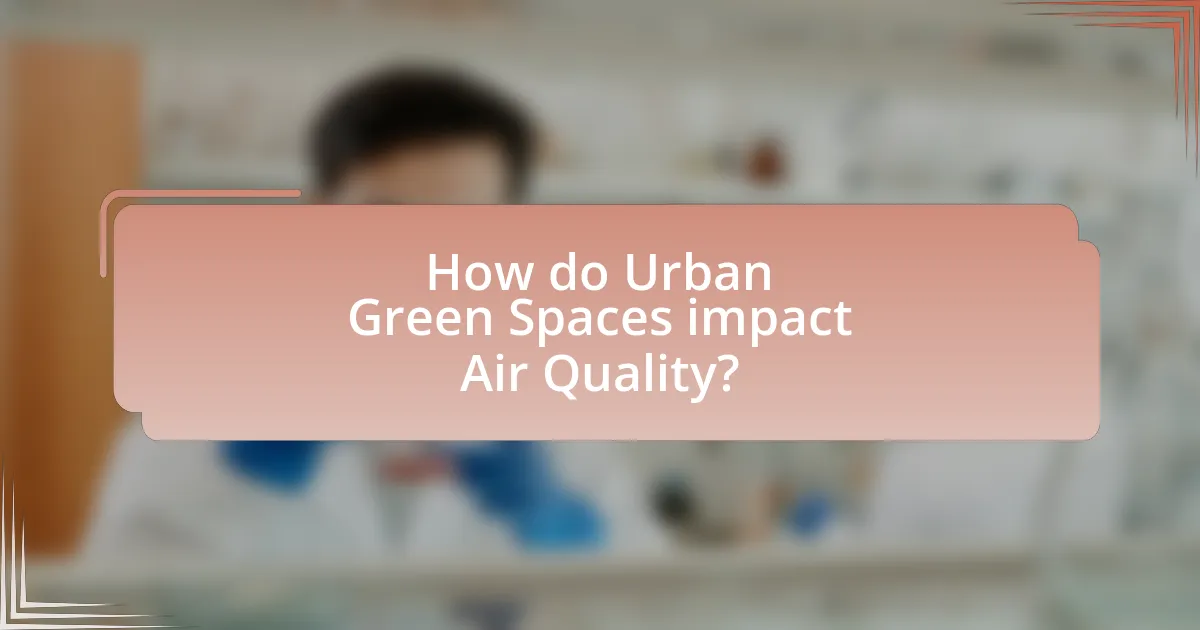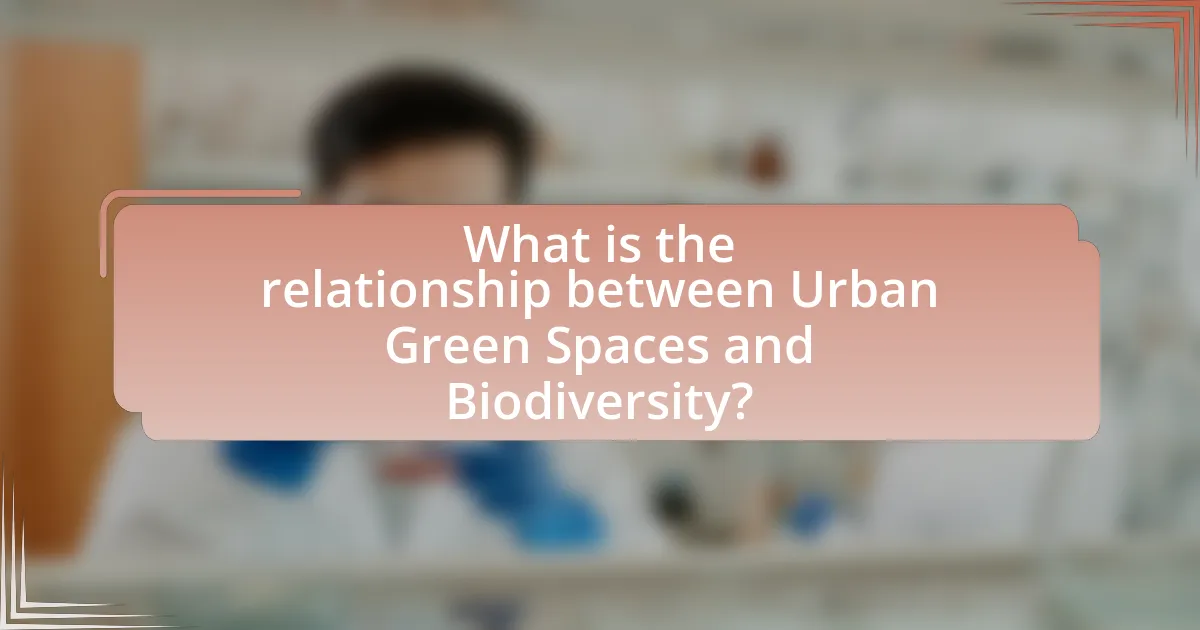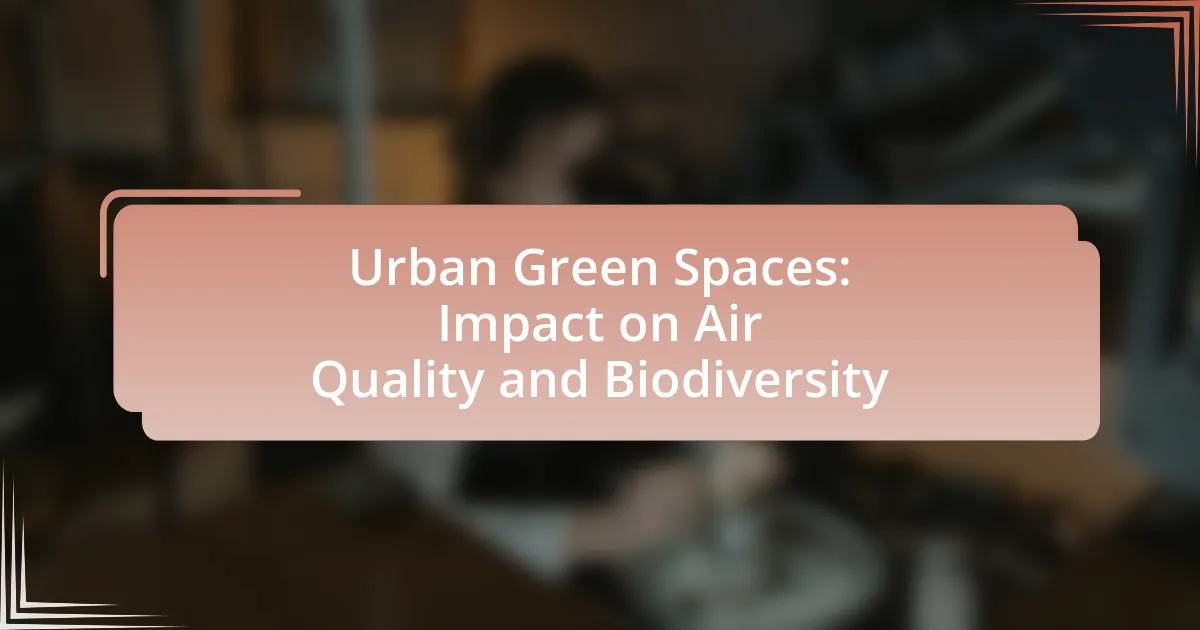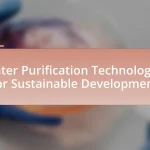Urban green spaces, including parks, gardens, and green roofs, are vital components of urban environments that enhance biodiversity and improve air quality. These areas serve as natural filters, absorbing pollutants and providing habitats for various species, thereby contributing to healthier ecosystems. Research indicates that urban green spaces can reduce air pollution levels by up to 30% and support a diverse range of flora and fauna, promoting ecological balance. The article explores the characteristics, types, and significance of urban green spaces, as well as their mechanisms for improving air quality and supporting biodiversity, while also addressing the challenges they face in urban settings.

What are Urban Green Spaces?
Urban green spaces are areas within urban environments that are primarily covered by vegetation, including parks, gardens, and green roofs. These spaces play a crucial role in enhancing urban biodiversity, improving air quality, and providing recreational opportunities for residents. Research indicates that urban green spaces can reduce air pollution levels by absorbing pollutants and providing oxygen, thereby contributing to healthier urban ecosystems. For instance, a study published in the journal “Environmental Science & Technology” found that urban trees can remove up to 1.7 million tons of air pollutants annually in the United States, highlighting their significant impact on air quality.
How do Urban Green Spaces differ from other types of urban areas?
Urban green spaces differ from other types of urban areas primarily by their incorporation of vegetation and natural elements, which enhance biodiversity and improve air quality. Unlike commercial or residential zones that prioritize built environments, urban green spaces such as parks, gardens, and green roofs provide habitats for various species and contribute to ecological balance. Research indicates that urban green spaces can reduce air pollution levels by up to 30% through the absorption of pollutants and carbon dioxide, thereby promoting healthier urban living conditions.
What characteristics define Urban Green Spaces?
Urban green spaces are defined by their accessibility, biodiversity, ecological functions, and recreational opportunities. These areas, such as parks, gardens, and green roofs, provide habitats for various species, contributing to urban biodiversity. They also play a crucial role in improving air quality by filtering pollutants and providing oxygen. Studies indicate that urban green spaces can reduce urban heat islands, enhance stormwater management, and promote physical and mental well-being among residents. For instance, a study published in the journal “Environmental Science & Technology” found that urban greenery can lower air pollution levels by up to 30%, demonstrating their significant environmental impact.
Why are Urban Green Spaces important in cities?
Urban green spaces are important in cities because they enhance air quality and support biodiversity. These areas, such as parks and gardens, act as natural filters, absorbing pollutants and releasing oxygen, which improves overall urban air quality. For instance, a study by the U.S. Environmental Protection Agency found that urban vegetation can reduce particulate matter by up to 60%. Additionally, urban green spaces provide habitats for various species, promoting biodiversity; research indicates that cities with more green areas have higher species richness. Thus, urban green spaces play a crucial role in creating healthier urban environments.
What types of Urban Green Spaces exist?
Urban green spaces include parks, gardens, green roofs, urban forests, and community gardens. Parks serve as recreational areas for the public, while gardens can be private or community-based, promoting biodiversity and local flora. Green roofs contribute to urban cooling and stormwater management, and urban forests enhance air quality and provide habitats for wildlife. Community gardens foster social interaction and food production, supporting urban sustainability. Each type plays a crucial role in improving air quality and enhancing biodiversity in urban environments.
How do parks contribute to urban ecosystems?
Parks contribute to urban ecosystems by enhancing biodiversity, improving air quality, and providing essential habitats for various species. They serve as green corridors that facilitate the movement of wildlife, thereby increasing species richness in urban areas. Research indicates that urban parks can reduce air pollutants by up to 30%, as vegetation absorbs carbon dioxide and filters harmful particulates. Additionally, parks support ecosystem services such as stormwater management and temperature regulation, which are crucial for maintaining ecological balance in densely populated areas.
What role do community gardens play in urban environments?
Community gardens play a crucial role in urban environments by enhancing biodiversity and improving air quality. These gardens provide habitats for various species, including pollinators and birds, which contribute to urban ecological diversity. Research indicates that urban green spaces, such as community gardens, can reduce air pollution levels by absorbing carbon dioxide and other harmful pollutants, thereby improving overall air quality. For instance, a study published in the journal “Urban Forestry & Urban Greening” found that urban vegetation can lower particulate matter concentrations, leading to healthier urban atmospheres.

How do Urban Green Spaces impact Air Quality?
Urban green spaces significantly improve air quality by reducing pollutants and increasing oxygen levels. Trees and vegetation absorb carbon dioxide and filter harmful particulates from the air, effectively lowering concentrations of pollutants such as nitrogen dioxide and sulfur dioxide. Research indicates that urban areas with more green spaces can experience up to a 30% reduction in particulate matter, which is crucial for respiratory health. Additionally, studies show that urban forests can sequester substantial amounts of carbon, further contributing to cleaner air.
What mechanisms do Urban Green Spaces use to improve Air Quality?
Urban Green Spaces improve air quality primarily through the processes of photosynthesis, particulate matter capture, and temperature regulation. During photosynthesis, plants absorb carbon dioxide and release oxygen, which enhances air quality. Additionally, vegetation captures particulate matter, such as dust and pollutants, on leaf surfaces, reducing airborne concentrations. Studies indicate that urban trees can remove significant amounts of particulate matter; for instance, a study by Nowak et al. (2014) found that urban trees in the United States removed approximately 711,000 tons of particulate matter annually. Furthermore, green spaces help lower urban temperatures through evapotranspiration, which can reduce the formation of ground-level ozone, a harmful air pollutant.
How do plants in Urban Green Spaces filter pollutants?
Plants in Urban Green Spaces filter pollutants through processes such as absorption, adsorption, and phytoremediation. These mechanisms allow plants to take up harmful substances like carbon dioxide, particulate matter, and volatile organic compounds from the air and soil. For instance, studies have shown that trees can absorb significant amounts of carbon dioxide, while leaves can trap particulate matter on their surfaces, effectively reducing air pollution levels. Additionally, certain plants can metabolize or store heavy metals and other contaminants in their tissues, thereby cleaning the soil and water in urban environments. Research indicates that urban vegetation can reduce particulate matter by up to 60% in some areas, demonstrating their critical role in improving air quality.
What is the role of trees in reducing urban heat and improving air quality?
Trees play a crucial role in reducing urban heat and improving air quality by providing shade and releasing moisture through transpiration. The shade from trees lowers surface and air temperatures, mitigating the urban heat island effect, which can increase temperatures by 2 to 5 degrees Fahrenheit in cities. Additionally, trees absorb pollutants such as carbon dioxide, sulfur dioxide, and particulate matter, while also releasing oxygen, thus enhancing air quality. Studies indicate that urban trees can remove approximately 1.7 million tons of air pollution annually in the United States alone, significantly contributing to healthier urban environments.
What evidence supports the impact of Urban Green Spaces on Air Quality?
Urban green spaces significantly improve air quality by reducing pollutants and enhancing overall environmental health. Studies have shown that vegetation in urban areas can lower levels of particulate matter (PM), nitrogen dioxide (NO2), and carbon dioxide (CO2). For instance, research published in the journal “Environmental Science & Technology” by Nowak et al. (2014) found that urban trees can remove approximately 711,000 tons of air pollution annually in the United States, leading to improved air quality and public health outcomes. Additionally, a meta-analysis conducted by Zhang et al. (2017) in “Urban Forestry & Urban Greening” indicated that urban green spaces can reduce PM concentrations by up to 30%, demonstrating their effectiveness in mitigating air pollution.
What studies have been conducted on air quality improvements due to Urban Green Spaces?
Numerous studies have demonstrated that urban green spaces significantly improve air quality. For instance, a study by Nowak et al. (2014) published in the journal “Environmental Pollution” found that urban trees can remove up to 1.7 million tons of air pollution annually in the United States alone. Another research conducted by Donovan and Butry (2010) in “The Journal of Environmental Management” indicated that increasing tree canopy cover in urban areas leads to a reduction in particulate matter and other pollutants, enhancing overall air quality. Additionally, a meta-analysis by Bowler et al. (2010) in “Environmental Science & Technology” highlighted that urban green spaces contribute to lower levels of nitrogen dioxide and sulfur dioxide, further supporting the positive correlation between greenery and improved air quality.
How do Urban Green Spaces compare to urban areas without green spaces in terms of air quality?
Urban green spaces significantly improve air quality compared to urban areas without green spaces. Studies indicate that vegetation in urban green spaces absorbs pollutants such as carbon dioxide, nitrogen dioxide, and particulate matter, leading to lower concentrations of these harmful substances in the air. For instance, research published in the journal “Environmental Science & Technology” found that urban trees can remove up to 1.7 million tons of air pollutants annually in the United States alone, demonstrating their crucial role in enhancing urban air quality.

What is the relationship between Urban Green Spaces and Biodiversity?
Urban green spaces significantly enhance biodiversity by providing habitats for various species. These areas, such as parks, gardens, and green roofs, support a wide range of flora and fauna, contributing to ecological balance. Research indicates that urban green spaces can increase species richness and abundance; for instance, a study published in the journal “Urban Ecology” found that urban parks can host up to 50% of the species found in nearby natural habitats. This relationship underscores the importance of integrating green spaces into urban planning to promote biodiversity and ecological health.
How do Urban Green Spaces contribute to urban biodiversity?
Urban green spaces enhance urban biodiversity by providing habitats for various plant and animal species. These areas, such as parks, gardens, and green roofs, create ecological niches that support diverse ecosystems. Research indicates that urban green spaces can increase species richness; for example, a study published in “Urban Ecology” found that parks in cities can host up to 30% more bird species compared to surrounding urban areas. Additionally, green spaces facilitate the movement of wildlife, allowing species to migrate and adapt to changing environments, which is crucial for maintaining genetic diversity.
What species benefit from the presence of Urban Green Spaces?
Urban green spaces benefit a variety of species, including birds, insects, mammals, and plants. These areas provide essential habitats, food sources, and breeding grounds, which are crucial for maintaining biodiversity in urban environments. For instance, studies have shown that urban parks can support over 100 bird species and numerous pollinator species, such as bees and butterflies, which rely on flowering plants found in these green spaces. Additionally, urban green spaces contribute to the survival of small mammals by offering shelter and foraging opportunities, thereby enhancing urban biodiversity.
How do Urban Green Spaces serve as habitats for wildlife?
Urban green spaces serve as vital habitats for wildlife by providing essential resources such as food, shelter, and breeding grounds. These areas, including parks, gardens, and green roofs, support diverse species by offering vegetation that attracts insects, birds, and small mammals. Research indicates that urban green spaces can enhance biodiversity; for instance, a study published in “Urban Ecology” found that urban parks can host up to 50% of the species found in nearby natural habitats. This demonstrates that even in urban settings, green spaces play a crucial role in sustaining wildlife populations and promoting ecological balance.
What challenges do Urban Green Spaces face in supporting Biodiversity?
Urban green spaces face several challenges in supporting biodiversity, primarily due to habitat fragmentation, pollution, and invasive species. Habitat fragmentation occurs when urban development divides green spaces into smaller, isolated patches, making it difficult for species to migrate and reproduce. Pollution from urban areas, including air and water contaminants, negatively impacts the health of flora and fauna, reducing species diversity. Additionally, invasive species often thrive in urban environments, outcompeting native species for resources and disrupting local ecosystems. These factors collectively hinder the ability of urban green spaces to sustain diverse biological communities.
How does urbanization threaten the biodiversity of Urban Green Spaces?
Urbanization threatens the biodiversity of Urban Green Spaces primarily through habitat fragmentation and loss. As cities expand, natural habitats are converted into built environments, reducing the area available for various species to thrive. A study by McKinney (2002) found that urban areas can lead to a decline in species richness, as many organisms are unable to adapt to the altered landscapes and increased human activity. Additionally, pollution from urban areas can degrade the quality of these green spaces, further impacting the flora and fauna that rely on them.
What management practices can enhance biodiversity in Urban Green Spaces?
Management practices that can enhance biodiversity in urban green spaces include creating diverse plant communities, implementing native species planting, and establishing habitat corridors. Diverse plant communities support a wider range of species by providing various food sources and habitats. Research indicates that urban areas with a higher proportion of native plants can support more wildlife, as native species are better adapted to local conditions and provide essential resources for local fauna. Additionally, habitat corridors facilitate movement and genetic exchange between isolated populations, which is crucial for maintaining biodiversity. Studies have shown that urban green spaces designed with these practices can significantly increase species richness and abundance, contributing to healthier ecosystems.
What best practices can be implemented to maximize the benefits of Urban Green Spaces?
To maximize the benefits of Urban Green Spaces, cities should implement integrated planning that prioritizes biodiversity, accessibility, and community engagement. Research indicates that diverse plant species enhance ecosystem services, improve air quality, and support wildlife habitats. For instance, a study by the University of California found that urban areas with a variety of native plants can increase local biodiversity by up to 30%. Additionally, ensuring that green spaces are easily accessible encourages community use, which fosters social cohesion and promotes mental well-being. Engaging local communities in the design and maintenance of these spaces can lead to more sustainable practices and increased stewardship, as evidenced by successful initiatives in cities like Melbourne, where community involvement has significantly improved green space quality and usage.
How can community involvement enhance the effectiveness of Urban Green Spaces?
Community involvement enhances the effectiveness of Urban Green Spaces by fostering stewardship, increasing usage, and promoting biodiversity. Engaged communities are more likely to take ownership of these spaces, leading to better maintenance and care, as evidenced by studies showing that parks with active community groups report higher satisfaction and lower vandalism rates. Additionally, when local residents participate in the planning and design of green spaces, they can ensure that these areas meet their needs, which increases visitation and encourages diverse activities that support local wildlife. Research indicates that community-led initiatives can improve plant diversity and habitat quality, thereby positively impacting overall biodiversity in urban environments.
What strategies can cities adopt to integrate more green spaces into urban planning?
Cities can adopt strategies such as creating green corridors, implementing zoning regulations that prioritize green space, and engaging in community-driven planning to integrate more green spaces into urban planning. For instance, green corridors can connect parks and natural areas, enhancing biodiversity and improving air quality by providing habitats for wildlife and reducing urban heat. Zoning regulations can mandate a percentage of land to be allocated for parks and green areas, ensuring that new developments contribute to urban greenery. Community-driven planning involves residents in the decision-making process, leading to green spaces that meet local needs and preferences, which has been shown to increase public support and usage of these areas.


